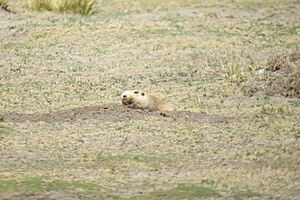Highland tuco-tuco facts for kids
Quick facts for kids Highland tuco-tuco |
|
|---|---|
 |
|
| Conservation status | |
| Scientific classification | |
| Genus: |
Ctenomys
|
| Species: |
opimus
|
| Subspecies | |
|
C. o. luteolus Thomas, 1900 |
|
The highland tuco-tuco (Ctenomys opimus) is a type of rodent that lives in South America. It belongs to the Ctenomyidae family. You can find these small animals in high grasslands across Argentina, Bolivia, Chile, and Peru. They spend most of their lives in burrows they dig underground.
Contents
What Does a Highland Tuco-Tuco Look Like?
Tuco-tucos are specially built for living underground in burrows. They have a short tail, small eyes, and tiny ears. This helps them move easily in tight spaces. Their front claws are big and strong, perfect for digging.
The fur of the highland tuco-tuco is longer and softer than other tuco-tuco types. Their heads are dark, while their upper bodies are light brown or yellowish-grey. Their sides and undersides are even paler. These animals store fat under their skin. Male tuco-tucos are usually bigger than females. A cool fact about them is that the front of their teeth, called incisors, are a bright yellowish-orange color!
Where Do Highland Tuco-Tucos Live?
The highland tuco-tuco lives on the eastern side of the Andes mountains. This mountain range stretches across the southern part of South America. Their home includes southwestern Bolivia, northwestern Argentina, southern Peru, and northern Chile.
They live at very high altitudes, from about 2,500 to 5,000 meters (8,200 to 16,400 feet) above sea level. You can find them in dry puna grassland areas. They like to dig their burrows in loose, gravelly, and sandy soils. They can live in both untouched natural areas and places where humans have changed the land.
How Do Highland Tuco-Tucos Live?
Each highland tuco-tuco lives alone in its own large burrow system. They dig tunnels using their strong front paws to loosen the soil. Then, they push the dirt backward with their hind legs.
A typical burrow has a main tunnel. Short side passages branch off every few meters. There are also special rooms for storing food and other rooms for nesting. Most of their activity happens in the morning. During this time, they extend their tunnels to reach roots and stems, which they eat. They only come out of their burrows for a short time to grab food nearby before quickly going back inside.
Baby tuco-tucos are born during the summer. A mother can have up to six young in one litter.
Are Highland Tuco-Tucos Endangered?
The highland tuco-tuco has a wide range across South America. It is quite common in many places. For example, in Peru, there can be as many as 17 tuco-tucos living in just one acre of land.
Scientists have not found any major threats to this species. Because of this, the International Union for Conservation of Nature (IUCN) has listed its conservation status as "least concern." This means they are not currently in danger of disappearing.


